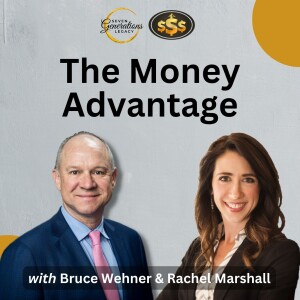
Interest Rates: What Does it Mean for Infinite Banking?
 2023-03-13
2023-03-13
Download
Right click and do "save link as"
Are you concerned about rising interest rates? How will they affect your Infinite Banking policies? What about inflation and infinite banking? What do interest rates mean for infinite banking?
https://www.youtube.com/watch?v=CbHu0HqwCWA
Today, we'll be discussing the infinite banking concept, and how it relates to interest rates. We'll also explore the implications of this concept for infinite banking customers and whole life insurance customers. We want you to have a better understanding of what interest rates mean for infinite banking. This includes the implications for you and your financial situation.
So, if you want to know what to expect ... tune in now!
Table of contentsThe Basic MechanicsInterest Rates Don’t Matter Interest Rates and Policy DesignShould You Have a High-Base Policy?Book A Strategy Call
The Basic Mechanics
When you work with a non-direct recognition company, there’s usually only one borrowing rate. The rate is based on the Moody Bond Index. At the time we recorded our podcast, most non-direct recognition companies were sitting at about 5 percent for their borrowing rate. Direct recognition companies generally have a variable borrowing rate. At the time of recording, it ranged from 3.25 percent up to 5 percent. (Note: At the end of the day, the long-term cash value outcomes are incredibly similar, whether you choose direct recognition or non-direct recognition. Don’t get too hung up on the distinction.)
The Moody Bond Index is a conglomerate of bonds that indicates the general trend of bonds.
[11:37] “So what the insurance companies do is they base their borrowing on that because they want to be competitive.”
Life insurance companies don’t mind lending money to policy owners, because they actually make a pretty good return. If they can make 5 percent on fully collateralized cash with their policyholders, they don’t have to risk that money in the market, even if the market in question is fairly safe. They raise rates as appropriate in order to remain competitive with the bond market.
While it can be frustrating to see interest rates being raised, there are still benefits for you, the policyholder. After all, mutual companies must share profits with all owners—AKA policyholders. By keeping borrowing rates competitive with bond rates, they can benefit policyholders in two ways—by providing access to cash AND by making a profit. That way, companies don’t lend at the expense of profits in the bond market. When the company pays dividends, you and all other policyholders benefit.
Interest Rates Don’t Matter
Nelson Nash has said time and time again, “Interest rates don’t matter.” So what does that mean, exactly?
[18:08] “If you have more and more money in the form of premiums go into the insurance company, those insurance companies are going to deploy that to make money for the policyholders. And that money is going to get paid back in the form of dividends. Seventy-five percent of that is in the form of bonds. So as interest rates go up—bonds are interest-rate sensitive—they will then pay out greater dividends. And throughout the history of these mutual companies, the dividend rate has always stayed above the lending rate.”
The life insurance companies are not interested in making less money than what they’re lending out, because they have to consider their policyholders. Life insurance companies are great at making a profit, and it’s to the benefit of everyone.
[19:10] “It’s really important to recognize the rising interest rate does not only affect the borrowing component of infinite banking. It also impacts your growth rate on the dividend side.”
Translation: don’t sweat it too much when loan rates increase, because that means everything else is increasing too. And with dividends, that means good things for you and all other policyholders.
Interest Rates and Policy Design
If you want to see for yourself how the interest rates and dividend ...
view more
More Episodes
Answers to Your Money Questions, Part 2
 2021-10-18
2021-10-18
 2021-10-18
2021-10-18
Answers to Your Money Questions, Part 1
 2021-10-04
2021-10-04
 2021-10-04
2021-10-04
Get Different, with Mike Michalowicz
 2021-09-27
2021-09-27
 2021-09-27
2021-09-27
Paid-Up Additions: The IBC Secret Sauce
 2021-09-20
2021-09-20
 2021-09-20
2021-09-20
The Holistic You, with Rabbi Daniel Lapin
 2021-08-30
2021-08-30
 2021-08-30
2021-08-30
IBC 201: How to Maximize Your IBC Policy
 2021-08-09
2021-08-09
 2021-08-09
2021-08-09
How Infinite Banking Loan Interest Works
 2021-07-26
2021-07-26
 2021-07-26
2021-07-26
5 Reasons Your Financial Plan is Failing
 2021-07-12
2021-07-12
 2021-07-12
2021-07-12
Bob Wheeler, the Money Nerve
 2021-07-05
2021-07-05
 2021-07-05
2021-07-05
Creating a Balanced Wealth Portfolio
 2021-06-28
2021-06-28
 2021-06-28
2021-06-28
012345678910111213141516171819
Create your
podcast in
minutes
- Full-featured podcast site
- Unlimited storage and bandwidth
- Comprehensive podcast stats
- Distribute to Apple Podcasts, Spotify, and more
- Make money with your podcast
It is Free
- Privacy Policy
- Cookie Policy
- Terms of Use
- Consent Preferences
- Copyright © 2015-2024 Podbean.com




